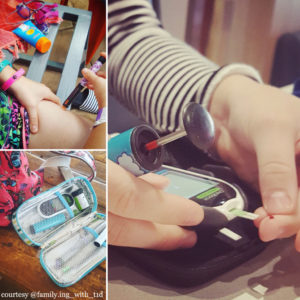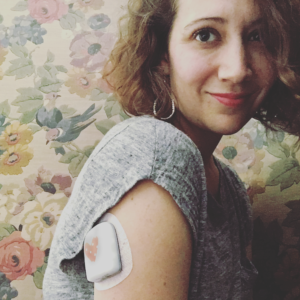 More than 200,000 kids and teens in the U.S.* are waking up today and acting as their own pancreas. As kids with Type 1 diabetes, they don’t really have a choice.
More than 200,000 kids and teens in the U.S.* are waking up today and acting as their own pancreas. As kids with Type 1 diabetes, they don’t really have a choice.
If you don’t have a child with Type 1 diabetes, there is a good chance you know one. And since November is American Diabetes Month, what better time to learn what kids with Type 1 (and their families) live with everyday?
The shared term “diabetes” makes it easy to get Type 1 and Type 2 mixed up, and maybe you aren’t sure what the difference is, other than just neither of them are good things.
Both types have to do with how a person’s body produces insulin and breaks down sugar in the bloodstream. Type-2 diabetes is most common: it’s insulin-resistance that often affects adults and has to do with genetics, diet, and lifestyle.
Type 1 diabetes makes up only about 5% of the cases of diabetes in the U.S.** and is quite different:
- Type 1 is also called juvenile diabetes because it is often onset during childhood or teen years (although it can occur in adults of any age).
- Type 1 is NOT caused by diet or lifestyle. The causes are uncertain – some cases can be traced genetically, but others appear “out of the blue.”
- Type 1 is an autoimmune disease – the body has attacked beta cells in the pancreas and caused it to stop producing insulin entirely. This means the body isn’t able to properly process sugar out of the bloodstream, which, if untreated, would eventually be fatal.
- Type 1 has to be managed with insulin injections. Since the body no longer makes insulin, the only option is to give synthetic insulin, which unfortunately must be taken subcutaneously (through the skin). Type 1 diabetics can either take multiple shots each day or wear an insulin pump that drips insulin through a tube inserted just beneath the skin.

- Since it’s easy to take too much or too little insulin (or eat more than you thought you would, be really active, get sick, get stressed about school, etc – many things affect blood sugar!) Type 1 diabetics have to regularly test blood glucose (blood sugar levels) with finger pricks to make sure they have the right ratio of insulin in their body.
Bonus lesson: Generally, high blood sugar means that person needs to take more insulin; low blood sugar means that person has too much insulin in their system and needs to eat or drink something to bring their blood glucose levels back up. Both can make a person feel crummy in the short run, but if left untreated can be extremely dangerous. ANOTHER bonus lesson: Some diabetics wear a device (a second device, if they are also wearing an insulin pump) called a continuous glucose monitor (CGM). These have a small receptor injected just under the skin that keeps a 24/7 check on blood sugar levels.
- There is no cure. Taking insulin allows a Type-1 diabetic to manage the diabetes, but there is nothing available yet that can repair the pancreas and make it produce insulin on its own again. This is why research funding is so important!
— — — — — — — —

Thankfully, I made it through my childhood and teen years before I was diagnosed with Type 1 diabetes. I was 25, and I’d taken a road trip with my husband where I drank everything in sight and had to stop the car for what felt like a few hundred times to keep going to the bathroom and finding more to drink (excessive thirst is a major symptom of T1, find more symptoms here). It was hard to miss something was wrong.
I headed straight to the doctor the morning after I got home, and my life expanded that day to include insulin vials, syringes (later, insulin pumps), glucose meters, and thousands of test strips that seem to fall out of my purse and follow me around like little diabetic footprints.
I remember, in those early diagnosis days, the thought I couldn’t seem to grasp – OK, but how can this be permanent? Without end? How can my fingers stand six pricks everyday for the rest of my life? Between that and the 5-6 daily shots, how can I take that much puncturing?
The answer for me is the same now as it was then: you just DO. You take it a day at a time. You’re thankful for the countless research hours and dollars spent to develop a cure and -in the meantime- better ways to live with it through improved technologies.
In my experience, and in talking to friends with children who are Type 1, that’s the thing to understand. It’s constant. There is no day off. The technology is great and allows T1 kids to participate in most things that other children are able to do. But everyday they (and often their caregivers) are operating a pancreas manually. It’s like a background news-ticker is running in their minds all day, every day, calculating how each meal, snack, exercise, nap, etc., will affect their blood glucose.
These kids and families will get up and do it again tomorrow, and the next day, and the next however-many-years until there is a cure. That cure is what I hope for – the day Type 1 diabetics can shift their pancreas back into automatic mode; when these kids and their families can shut off that news-ticker, put away the needles and supplies, and get back to the business of childhood.
For more information on Type 1 diabetes, visit the Juvenile Diabetes Research Foundation (JDRF) or the American Diabetes Association (ADA).
*Statistics from the JDRF
**Statistics from the ADA














Great article! I was diagnosed in my early 30s and like you said, there is no time off. I am now on an insulin pump and I love it! The pump is worth the hassle of changing it out every three days, cause I finally get to eat like a normal person. I just count the carbs and the pump puts in the proper amount of insulin. And, you are right, the pump also injects insulin constantly along with the the extra that I put in. So thankful for this pump!